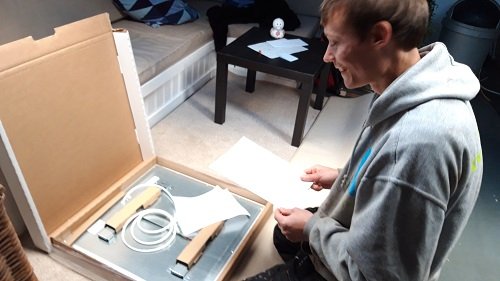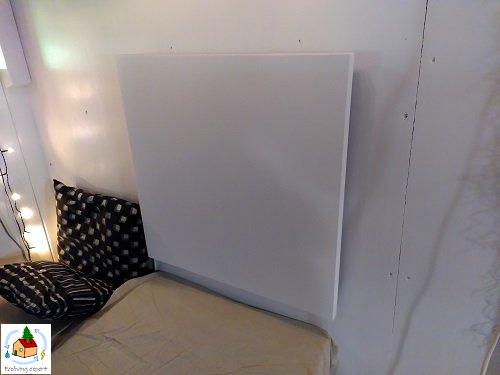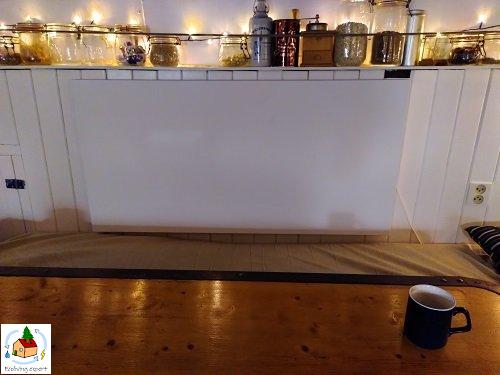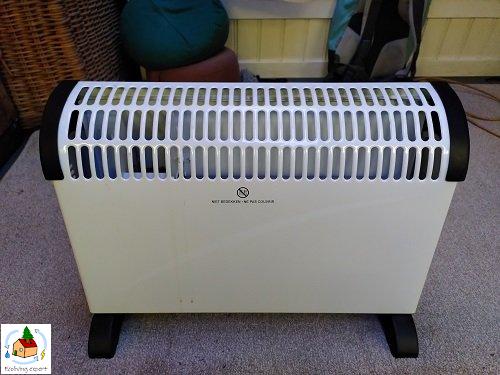Hi! My name is Anne Johan and in this blog post, I will share my personal experience with infrared heating panels as well as that of friends and family. I will update this post whenever I learn more about infrared panels.

What is an infrared heating panel?
Infrared heating panels are thin aluminum panels that provide space heating through infrared radiation. Infrared heating panels work on electricity.
You can read all about infrared heating panels in my article: Infrared heating panels at home: what, how, and why.
Our current situation and why we chose infrared
In this article, I will discuss my experience, thoughts, and recommendations on infrared heating panels. But first I need to explain my current situation so you know what my thoughts are based upon.
At the end of summer 2020, my girlfriend and I moved into an old uninsulated space. We were interested in infrared heating panels because they are very easy to install and use. Because of the potential to use green electricity to power them, we decided to see if they can function as the primary source of heating.
So keep in mind that we practically do not have insulation and do not have a central heating system.
My thoughts on infrared panels (10-2-2021)
I own two infrared heating panels. A small 300 W panel and a larger 700 W panel. They are both being used to keep us warm during the cold Dutch winter of 2020/2021.
At the time of writing, we are in the coldest week in decades in the Netherlands. Outdoor temperatures are constantly a few degrees below freezing. Therefore, these pros and cons are based on my current experience in the cold.
Pros
Cons
- The heat feels wonderful, just like sitting in the sun
- The relatively cool indoor air feels much fresher than regular warm indoor air
- They work so quickly that we get warm very fast
- I can leave them on 24/7 without any worries of safety or air quality issues
- Zone heating saves energy by not heating the whole house
- With indoor temperatures below 60°F (15°C), my feet are still cold, therefore;
- Additional warm air heating is required
- The panels have no way of adjusting the heat output. Just on or off
- Cabinets are not heated, making pots and pans feel very cold in winter
- I feel stuck in the area where the panels are since the rest of the house is cold
Our infrared heating experience
My girlfriend and I currently live in a very poorly insulated space where the only form of heating is our two infrared heating panels (1000 watts in total). We just moved in and need to build most of the living space and facilities ourselves. Therefore, to be able to start living there and get the heating done quickly, we wanted a simple elegant solution. On top of that, we are always looking for sustainable options.
At first, we bought a small 300 W infrared heating panel to see and feel what this form of heating is like. This panel is approximately 2 by 2 feet (60 by 60 cm). We have an area with a very low ceiling under which a couch is situated. Therefore, we decided to mount the panel on the ceiling, about 4 feet above the couch.
Unfortunately, since it was already getting colder outside (about 50°F/10°C) this was not at all enough to get warm. Honestly, we could hardly feel the heat.
Therefore, we decided to move the panel to the wall behind the seating area. In this way, we could sit one person directly in front of it, with their back almost against the panel. Because of this, we could more easily experience the heat.
The following picture shows our setup:

We were very happy with the result when I used it to work at home and did not need the whole room to be heated. I just sat in front of the panel and used a blanket to cover my legs. In this way, I can work for hours, even when the room temperature gets around 60°F (15°C).
Adding 700 watts of infrared heating panels
Because we were enthusiastic about the 300 W panel as personal heating, we decided to purchase a large 700 W panel to try and heat the whole room. This 700 W panel is 4 by 2 feet (120 by 60 cm) and fits perfectly at the back of our seating area. The space we want to heat with this combined total of 1000 watts is about 100 square feet (9 m²) and very poorly insulated.
The following picture shows our 700 W panel on the wall in the main seating area:

And it works very nicely! We are really happy with the results. Even during the winter, it can be very hot close to the panel. Even while the indoor temperature is as low as 50 degrees Fahrenheit (10 degrees Celsius). I took a picture of the temperature, see below.
I sometimes even take off my vest as my back gets really warm when sitting in front of the 700 W panel. However, during the winter, we do still use a blanket to cover our legs.

With 1000 watts of infrared heating, mounting the panels to the ceiling is probably the best option. In this way, the warm radiation is not blocked by any objects and can warm the room most effectively. However, in our situation, this is not an option (yet) so we mounted both panels to the wall.
Adding an electric radiant heater in a larger room
The 100 square-foot poorly insulated room that we heat with our 1000 watts of infrared is closed off by two outdoor walls, an indoor wall, and a curtain. The curtain is placed to keep the heat in this small area.
However, when we open the curtain we have a room of about 300 square feet (28 m²). To be able to heat the entire room, especially during winter, we added a 2000 W electric radiant heater. With a total of 3000 watts of heating, we can easily heat the whole room.

What you get from a small 200 or 300-watt infrared panel
A small 200 or 300-watt infrared heating panel is mostly useful as additional personal heating. It can heat a room up to 43 square feet (4.3 m²) such as a toilet.
My parents have a 200-watt panel mounted to an angled ceiling about 5 feet above the couch. This is unfortunately not enough wattage to really feel the warmth when sitting on the couch.
We mounted our 300 W panel about 4 feet above our couch, but that still wasn’t nearly enough. Of course, because this was our only form of heating in a poorly insulated area, it wasn’t much of a surprise that 300 watts weren’t enough. However, it could very well be that a small room with good insulation is heated nicely by a 300 W panel. In fact, our seller said he used a 300 W panel in his own toilet to great effect.
What you get from 1000 watts of infrared heating
1000 watts of infrared heating can heat a well-insulated area of 143 square feet (14,3 m²).
With our 1000 watts of infrared heating panels, we are able to heat our small poorly insulated 100 square feet (9 m²) room comfortably. Although, during the winter months when the temperature can be around 32 Fahrenheit (zero degrees Celsius), a blanket to cover our legs is highly preferred.
As I discuss in my article: How much energy does an infrared heater use?, infrared heaters use about 7 watts per square foot (0.1 m²). This means that, in a well-insulated living room, 1000 watts of infrared can warm an area of 143 square feet (14,3 m²). That seems to match with our poorly insulated 100 square feet being heated by our 1000 watts.
What is included when you buy an infrared heating panel?
Our Ecosun infrared heating panels came in a cardboard box. Inside the box were:
- the panel itself
- the mounting frame, and
- a piece of paper with mounting instructions

The infrared panels we bought are white, have a rough surface, and include 4 iron straps/shackles to hang the panel onto the mounting frame.
Additionally, an electricity cable of approximately 6.5 feet (200 cm) without a power plug is coming from the back of the panel. A power plug is not included because, when you want to connect the panel to the electricity cables in your home, you will need to cut it off. Cutting off the power plug, however, makes you lose the warranty.
Connecting a power plug is quite easy, and can be done without losing your warranty. We connected a power plug ourselves.
Concluding thoughts on infrared heating
- Infrared heat feels just like the warmth of the sun. This, to me, is one of the most relaxing and comfortable forms of heat.
- During winter, when temperatures get close to freezing, infrared panels have a hard time heating the room to a comfortable level. Although it is still nice when sitting in front of a panel, additional air heating is required to make the room feel comfortable.
- Things that are not in sight of the panels do not get heated. Therefore, your legs and feet can get cold when sitting at a table. So, a blanket to cover your legs is recommended, especially in a poorly insulated room or if infrared heating is your only form of heating.
- No controls such as buttons or a fancy touchscreen is honestly quite a relief. You can simply connect the panel to the socket to turn it on, and unplug it to turn it off. As I have always learned, no fancy buttons or screens means they can’t break down either.
- Up to 20 cm from the panels, the heat is quite intense. Fortunately, the panels themself do not get too hot (at max 194 Fahrenheit/ 90 degrees Celsius) and can be touched for about 2 seconds.
- Infrared heating panels are perfectly quiet, which is really wonderful. Especially compared to other electric heaters that use a fan to circulate warm air.
- Infrared heating panels are very easy to install and only require a plain wall or ceiling to screw on the mounting frame. Additionally, you will need to connect them to a socket or directly to your electricity cables.
- You can always install a thermostat and connect the panels to it. In this way, the panels can shut down automatically when it gets to the desired temperature. However, I can imagine that, since the panels do not heat the air, you’ll be comfortable with a relatively low room temperature. I haven’t tested this yet as I do not have a thermostat installed.
- No fear of fire hazard. A piece of paper will not burn even if it is laying directly on a panel.
- Infrared heating can be about 40% more efficient than other electric heaters. This is the case because the air is not heated, so the heat does not cling to the ceiling or gets blown away by a draft. You can read all about it in my post: How much energy does an infrared heater use?
- Electric heating can be very sustainable if you purchase sustainable energy
- 10 years warranty and no maintenance whatsoever!
I wrote an entire article on all the advantages and disadvantages of infrared heating panels. You can find it here: Infrared heating pros and cons.
The infrared panel I recommend: Ecosun
Before deciding which panels I was going to buy, I looked around the internet for prices, sizes, and wattages available. Eventually, I decided to contact a local (Dutch) seller to get some more information.
The seller was very helpful and enthusiastic about the Ecosun panels that he sells. He convinced me that I was better off purchasing a good quality model that also gave 10 years of warranty. So eventually, I decided I wanted to try them out. Therefore, I bought my first small Ecosun 300 W infrared panel from him.
Since we were very happy with this panel, we decided to order another Ecosun panel. We own them for a few months now and they keep us warm during the winter.
So, although I haven’t tested any other brands of infrared heating panels, I do highly recommend the Ecosun panels based on our positive experience.
